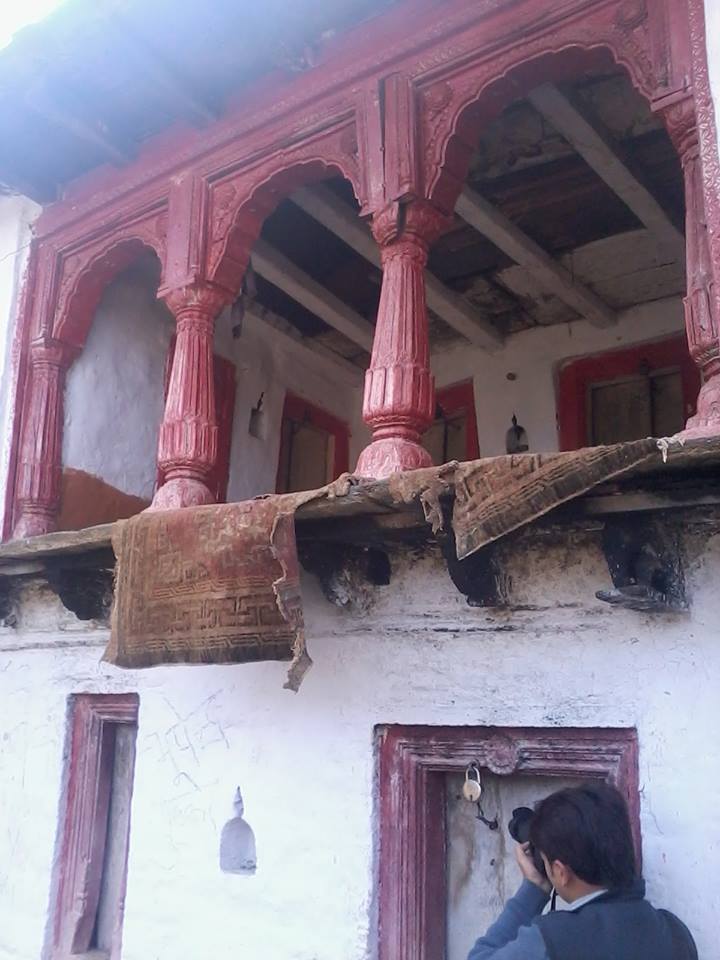The Ghost Villages of Uttarakhand

Intricately carved houses remain locked at Barsu Village, Rudraprayag District, Uttarakhand , India. Photo by Sudipto Sengupta
Editor’s Note: Tourists when they visit Uttarakhand wish they could leave the humdrum of urban life and settle in the serenity of the hills. Ironically people staying in the hills are leaving for the humdrum of urban life leaving number of abandoned villages behind. The author during his stint as a consultant with the Government of Uttarakhand for flood rehabilitation visited one such village.
Village Barsu  is about, 8 kms from the busy Rudraprayag town. Located on the recently constructed PMGSY road, the village is approached from the road through a rocky pathway over-layed by heavy bushes. The area is serene but desolate , not a soul to be seen.
A boarded house at Barsu Village, Rudraprayag District, Uttarakhand, India. Photo by Sudipto Sengupta
Suddenly out of nowhere come into vision some beautiful old wooden houses with slate roofs, intricately carved door frames ornate balcony columns and boarded windows. On door of every house are seen old rusted locks. The step fields where once crops used to grow are now rummage of bushes and weeds, the irrigation water channel from a stream above is blocked due to disuse. Electricity lines are seen as well as drinking water pipelines and the tank are present. The cattle sheds are now used by sloth-bears and leopards during the rains. The erstwhile residents renovated the village temple recently and congregate once a year. The wind whistles through the mango and lichi trees, giving the place an eerie feel.
Another house in Barsu village awaiting for residents to come back. But will they ? Photo by Sudipto Sengupta
According to the locals the village was established in early 1600s, and had about 85 households of the Semwals and the Nautiyals . Local lore identifies the Semwals and Nautiyals to be from Kerala who came along with Adi Shankracharya in the 9th century to the Garhwal mountains and settled down in the vicinity of Kedarnath temple. As their population grew they established new habitations, Barsu being one of them.
The outmigration(locally known as Palayan) from Barsu started about 20 years back, given the lack of facilities and a good approach road. The last family to migrate out of Barsu was Arvind Semwal, an armyman — left Barsu in the summer of 2010, no one has stayed in this ‘ghost’ village since. For some time lands were given to Nepali labourers to till, however they also left in 2011. The out migration was a result of difficult access and basic amenities. Also the residents of the village ,which have produced two brigadiers and atleast one civil servant in the central services, wished for better lifestyle and migrated out. Many of whom now stay in Rudraprayag town. By the time the amenities like road, electricity and watersupply reached it was too late.
Barsu is not alone, there are about 840 uninhabited villages in the State, many completely desolate and in some agriculture still goes on. The worst affected is Pauri district with 300 such villages. There are many neighbouring villages to Barsu which remain in desolate silence, their residents having long left, include Cham Gudhera, Gwar, Bauntha and Ghaniyalka villages.
There are many reasons for such mass migration include increased aspiration of the youth, agriculture is not remunerative, shifting of sources of water due to environmental changes and requisite amenities in terms of health and education taking time to reach.
It will not be easy to repopulate these abandoned villages, home stay and allied tourism activity can be one option (abandoned Saur village in Tehri is now getting a makeover), boosting alternate livelihood could be another. But most importantly the challenge is to prevent more villages being added to this list. Walls of the houses in Barsu village have lots to say, only if there was someone to listen.





